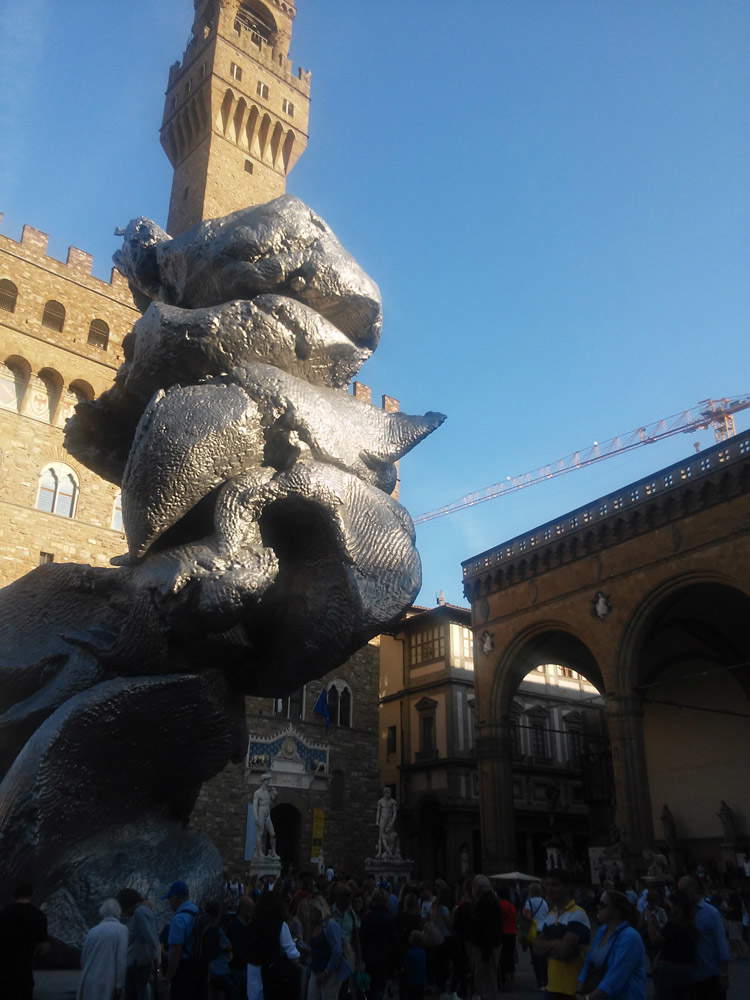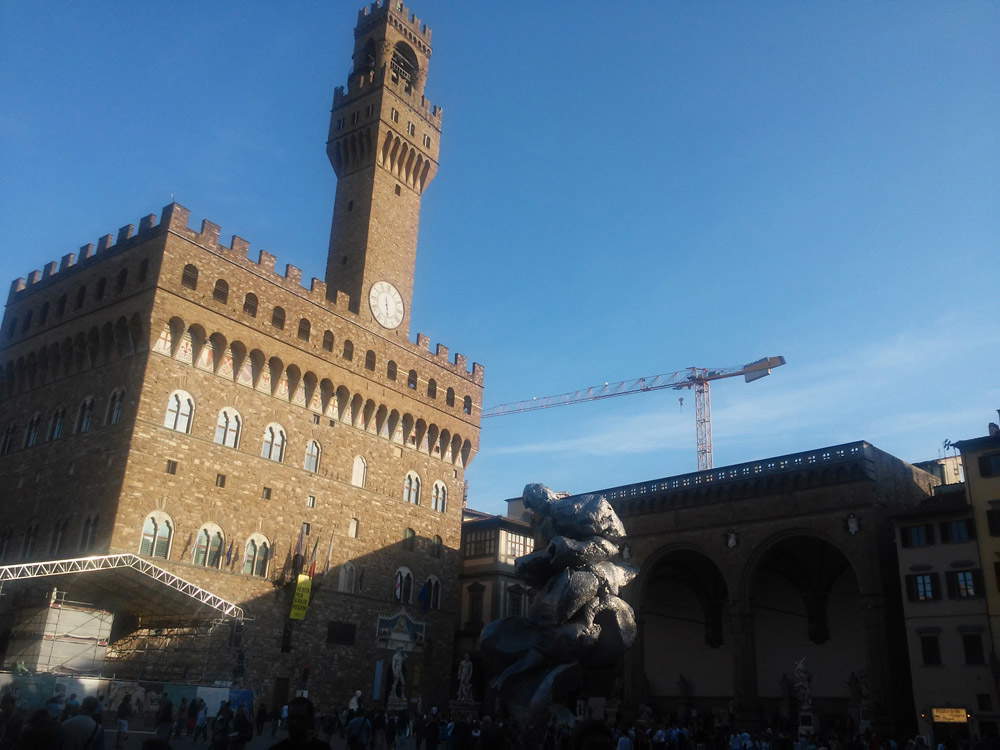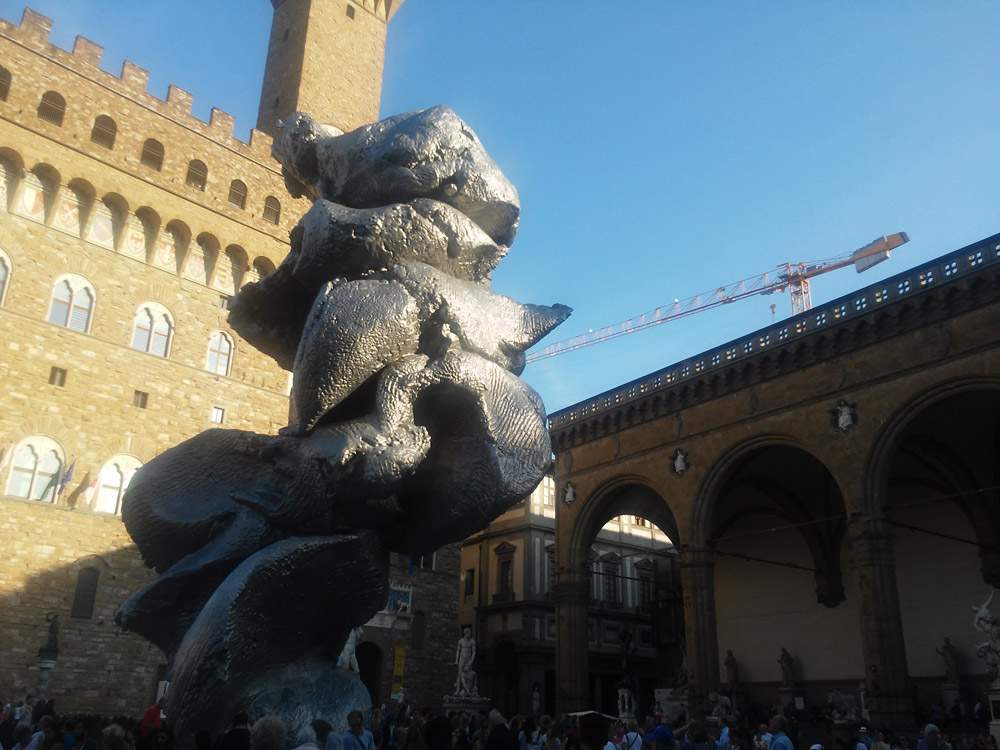Urs Fischer's work in Piazza della Signoria has nothing scatological about it. However.
Admirers of Urs Fischer assure that his Big Clay #4, the great twelve-meter-high work that plunged into Florence’s Piazza della Signoria on a sunny late-summer afternoon, has nothing scatological about it: that huge pile of metal, which to most seemed to be the blow-up of a coprolite, is actually a stack of small pieces of clay, which the Swiss sculptor modeled from life in his studio and then enlarged them, complete with the artist’s fingerprints carefully left in place in plain sight, and reproduced them in steel and aluminum. The reference is to the primordial gesture of the artist, who is a man even before he is an artist, and who uses matter to mold and shape it: what Urs Fischer brings to Florence, in short, is nothing more than the embryonic stage of creation. The first impact with the work confronts us, however, with a problem.
 |
| Urs Fischer, Big Clay #4 (2013-2014; steel and aluminum, height about 12 meters). Ph. Credit Finestre Sull’Arte |
 |
| Urs Fischer, Big Clay #4 in Piazza della Signoria. Ph. Credit Finestre Sull’Arte |
 |
| Urs Fischer, Big Clay #4. Ph. Credit Finestre Sull’Arte. |
And the real problem is not so much the opportunity to exhibit the abominable (at least according to most) pile of metallic clay in the most famous square of the Tuscan capital: at most, it will be a matter of waiting for January 21 to come and for the Blackbird Days to take away the “big clay.” It is in the end a temporary work, and the monotonous clamor of those who cry about the defacement of the square would perhaps do better to address themselves elsewhere: if it is really necessary to talk about works in Florence that come between the retinas of lovers of beauty and the objects of their aesthetic yearnings, then the crane at the construction site of the new Uffizi, for example, is to date far more enduring installation than Big Clay #4, and in theory would disturb far more than the latter. Indeed, wishing to utter a thought that to Florentines might sound like blasphemy, in the movement of Big Clay #4 we almost seem to discern a serpentine motion similar to that which animates Giambologna ’s Rape of the Sabine Women that we see a few meters away, under the Loggia dei Lanzi.
The main problem, we said, would seem to be the persevering desolation that characterizes the contemporary proposals at Palazzo Vecchio. First came the tired remnant of pop art, which two years ago arrived with an eighteenth-century porcelain ingratiated (he, too) and appropriately pulled together. Then it was the turn of the man who in theory was supposed to measure clouds, but who seemed at best to measure the size of the ashlars of Palazzo Vecchio (nothing against Jan Fabre’s work, indeed: but the Arengario was an extremely unfortunate location, and fortunately a replica was on display in the more suitable Forte del Belvedere, at the Belgian artist’s solo show). The saga of déjà -vu now continues with a work that not only had already been seen elsewhere (which, by the way, would not be a bad thing at all), but which adds nothing to the artistic career of an Urs Fischer who, in the course of his career, has certainly been able to achieve more substantial goals: and, incidentally, let’s gloss over the statues of the two curators of the event, Fabrizio Moretti and Francesco Bonami, if only for the simple fact that it is a crude re-edition of the topos, typical of Fischer, of the dripping wax statue. In Italy, moreover, Fischer had already produced a similar action by creating a wax copy of Giambologna’s Ratto mentioned above, only to have it melt during the 2011 Venice Biennale.
Without wishing to go to the extremes of critic Jeremy Sigler, who, at the time of Big Clay #4 ’s exhibition in New York, had wondered whether the work was not well suited to the flattering epithet of “the most expensive turd in the art casino” and for the coveted appellation had put Urs Fischer in competition with Jeff Koons and especially Paul McCarthy (an artist, the latter, whom we remember here in Carrara for having brought us, seven years ago, a work that truly reproduced a human dejection and was placed, with that magical touch of highly original irreverence, in front of the headquarters of the Cassa di Risparmio di Carrara), there would already be much to discuss about the content of the work, about that Oldenburg-like gigantism that, sixty years later, would perhaps have even grown a bit tired, about that taste for provocation that, though better concealed than the more open and blatant taste of artists like the aforementioned Koons or like Cattelan, Hirst, Serrano, Černý and assorted instigators, still has a rather stale flavor. And again on the fact that, even without bothering De Kooning’s bronze Heads and Figures, already when confronted with the works of artists such as Rebecca Warren (who moreover won the Turner Prize in 2006 precisely with some works in unbaked clay, which in its basic intentions were not so dissimilar to Fischer’s Big Clay #4) or Mark Manders, Big Clay #4 loses that aura of original surprise that it will probably have taken on as much in the eyes of its detractors as in those of its staunchest defenders.
Certainly that ancestral simplicity remains undoubtedly fascinating, posing a further questioning of the monumentality of the work, and which, for contemporary exhibitions in the Piazza della Signoria, is unprecedented, but this is probably not enough to arrest the constant stream of doubts that assail us upon seeing Big Clay #4 engulfing the works of the greats of the sixteenth century. Perhaps, at the end of this exhibition, what we will best remember will be the irony of the Florentines, who have notoriously been reluctant for centuries to reserve a good reception for any form of novelty that happens upon their main piazza: so now, next to the sack of melons (Baccio Bandinelli’sHercules and Cacus ) and the beautiful ruined marble (Bartolomeo Ammannati’s Neptune ), we have yet another work for which the Florentines will surely have already found an icastic definition.
Warning: the translation into English of the original Italian article was created using automatic tools. We undertake to review all articles, but we do not guarantee the total absence of inaccuracies in the translation due to the program. You can find the original by clicking on the ITA button. If you find any mistake,please contact us.





























